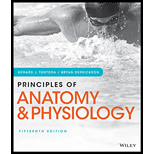
Principles of Anatomy and Physiology
15th Edition
ISBN: 9781119329398
Author: Gerard J Tortora, Bryan Derrickson
Publisher: John Wiley & Sons Inc
expand_more
expand_more
format_list_bulleted
Concept explainers
Textbook Question
Chapter 29, Problem 1CTQ
Kathy is breastfeeding her infant and is experiencing what feels like early labor pains. What is causing these painful feelings? Is there a benefit to them?
Expert Solution & Answer
Want to see the full answer?
Check out a sample textbook solution
Students have asked these similar questions
pls help
What habitat/environment is the colobus monkey found in
4
Chapter 29 Solutions
Principles of Anatomy and Physiology
Ch. 29 - 1. What is pregnancy?
Ch. 29 - 2. What are the major events of each trimester?
Ch. 29 - Prob. 3CPCh. 29 - How is polyspermy prevented?Ch. 29 - Prob. 5CPCh. 29 - Describe the layers of a blastocyst and their...Ch. 29 - Prob. 7CPCh. 29 - 8. What are the functions of the trophoblast?
Ch. 29 - How is the bilaminar embryonic disc formed? ^Ch. 29 - Prob. 10CP
Ch. 29 - Prob. 11CPCh. 29 - When does gastrulation occur?Ch. 29 - Prob. 13CPCh. 29 - Prob. 14CPCh. 29 - Describe how neurulation occurs. Why is it...Ch. 29 - Prob. 16CPCh. 29 - Prob. 17CPCh. 29 - 18. How does the placenta form?
Ch. 29 - Prob. 19CPCh. 29 - Prob. 20CPCh. 29 - What is the origin of the structures of the head...Ch. 29 - Prob. 22CPCh. 29 - What changes occur in the limbs during the second...Ch. 29 - What are the general developmental trends during...Ch. 29 - Prob. 25CPCh. 29 - 26. What are some of the symptoms of fetal alcohol...Ch. 29 - How does cigarette smoking affect embryonic and...Ch. 29 - What conditions can be detected using fetal...Ch. 29 - List the hormones involved in pregnancy, and...Ch. 29 - 30. What structural and functional changes occur...Ch. 29 - 31. Which changes in pregnancy have an effect on...Ch. 29 - Prob. 32CPCh. 29 - Prob. 33CPCh. 29 - What happens during the stage of dilation, the...Ch. 29 - Why are respiratory and cardiovascular adjustments...Ch. 29 - Which hormones contribute to lactation? What is...Ch. 29 - Prob. 37CPCh. 29 - What do the terms genotype, phenotype, dominant,...Ch. 29 - What are genomic imprinting and nondisjunction?Ch. 29 - Give an example of incomplete dominance.Ch. 29 - 41. What is multiple-allele inheritance? Give an...Ch. 29 - Define complex inheritance and give an example.Ch. 29 - 43. Why does X-chromosome inactivation occur?
Ch. 29 - Kathy is breastfeeding her infant and is...Ch. 29 - 2. Jack has hemophilia, which is a sex-linked...Ch. 29 - Alisa has asked her obstetrician to save and...
Additional Science Textbook Solutions
Find more solutions based on key concepts
Practice Problem 1.22 Which of the following alkenes can exist as cis-trans isomers? Write their structures. Bu...
Organic Chemistry
To test your knowledge, discuss the following topics with a study partner or in writing ideally from memory. Th...
HUMAN ANATOMY
Describe the role and impact of microbes on the earth.
Microbiology Fundamentals: A Clinical Approach
On what molecule does the anticodon appear? Explain the role of this molecule in protein synthesis.
Human Physiology: An Integrated Approach (8th Edition)
What are the cervical and lumbar enlargements?
Principles of Anatomy and Physiology
Knowledge Booster
Learn more about
Need a deep-dive on the concept behind this application? Look no further. Learn more about this topic, biology and related others by exploring similar questions and additional content below.Similar questions
- Does it show the level of proteins? What about the amount? Levels of protein activation? How can you tell? Does the thickness tell you anything? What about the number of the lines? And the other questionsarrow_forwardKD 200- 116- 66- Vec ATF6 (670) ATF6 (402) ATF6 (373) ATF6 (366) I I 45- 1 2 3 4 5 ATFG (360) (e/c) 9V ATFG (402) g ant- ATF anti-KDEL DAPI barrow_forwardWestern blot results: what information can you get? Presence of proteins of your interest Levels of protein expression Levels of protein activation (must use activation state-specific antibody) Decreased function of the ATM kinase in aging mice. A C57BL/6 female 6 month Con IR 20 month C57BL/6 male 6 month 28 month Con IR Con IR Con IR p-ATM (S1981) ATM P-p53 (ser18) Actinarrow_forward
- Does it show the level of proteins? What about the amount? Levels of protein activation? How can you tell? Does the thickness tell you anything? What about the number of the lines?arrow_forwardWB: Protein of interest visualized by fluorescent Protein A Protein Barrow_forwardQuestion #4: Assume you are able to use CRISPR to create an allele that will convert a cross-pollinated, sexually reproducing crop plant into an obligate apomict. Your edited obligate apomict plants retains all the CRISPR "machinery" necessary to convert the "sexually reproducing" allele to the "obligate apomict" allele. You plant 100 hectares of your edited obligate apomicts in order to increase seed for sale the following year. Neighboring farms and seed producers are growing many different un-edited sexually reproducing varieties of the crop. If your neighbors plant seed harvested from their crops that was pollinated by your crop, should they expect these seeds to generate apomictic or non-apomictic plants? Type your answer here:arrow_forward
- calculate the questions showing the solution including variables,unit and equations all the questiosn below using the data.show solving and answer a) B1, b) B2, c) hybrid rate constant (1) d) hybrid rate constant (2) e) t1/2,dist t1/2,absorb f) t1/2,elim k) apparent central compartment volume (V1,app) p) total AUC (using short cut method) apparent volume of distribution based on AUC (VAUC,app) apparent clearance (CLapp) absolute bioavailabilty of oral route ( AUCiv =116ml)arrow_forwardPlease help me to draw this by hand. In as much detail as possible, hand draw a schematic diagram of the hypothalamic-pituitary-gonad (HPG) axis in the human female. Be sure to include all the relevant structures and hormones. You must define all abbreviations the first time you use them. Please include (and explain) the feedback loops.arrow_forwardPlease refer belowarrow_forward
- AaBbCc X AaBbCc individuals are crossed. What is the probability of their offspring having a genotype AABBCC?arrow_forwardcircle a nucleotide in the imagearrow_forward"One of the symmetry breaking events in mouse gastrulation requires the amplification of Nodal on the side of the embryo opposite to the Anterior Visceral Endoderm (AVE). Describe one way by which Nodal gets amplified in this region." My understanding of this is that there are a few ways nodal is amplified though I'm not sure if this is specifically occurs on the opposite side of the AVE. 1. pronodal cleaved by protease -> active nodal 2. Nodal -> BMP4 -> Wnt-> nodal 3. Nodal-> Nodal, Fox1 binding site 4. BMP4 on outside-> nodal Are all of these occuring opposite to AVE?arrow_forward
arrow_back_ios
SEE MORE QUESTIONS
arrow_forward_ios
Recommended textbooks for you
 Nutrition Through The Life CycleHealth & NutritionISBN:9781337919333Author:Brown, Judith E.Publisher:Cengage Learning,
Nutrition Through The Life CycleHealth & NutritionISBN:9781337919333Author:Brown, Judith E.Publisher:Cengage Learning,- Health Safety And Nutrition F/Young ChildHealth & NutritionISBN:9781305144767Author:MAROTZPublisher:Cengage



Nutrition Through The Life Cycle
Health & Nutrition
ISBN:9781337919333
Author:Brown, Judith E.
Publisher:Cengage Learning,



Health Safety And Nutrition F/Young Child
Health & Nutrition
ISBN:9781305144767
Author:MAROTZ
Publisher:Cengage
How to solve genetics probability problems; Author: Shomu's Biology;https://www.youtube.com/watch?v=R0yjfb1ooUs;License: Standard YouTube License, CC-BY
Beyond Mendelian Genetics: Complex Patterns of Inheritance; Author: Professor Dave Explains;https://www.youtube.com/watch?v=-EmvmBuK-B8;License: Standard YouTube License, CC-BY